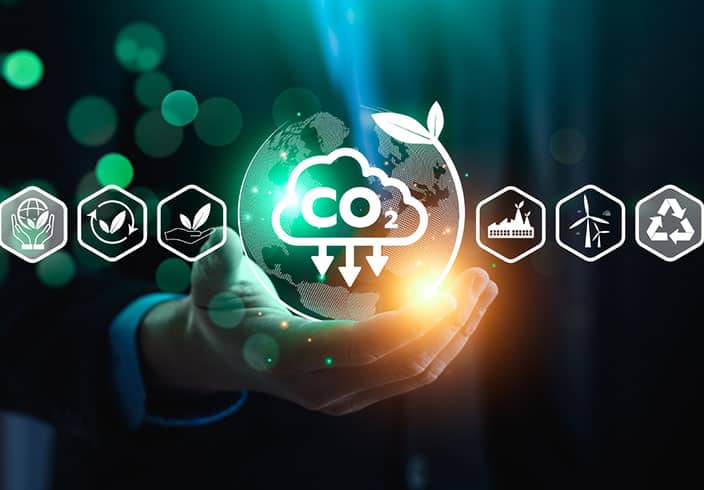Heat waves, floods, wildfires – the global impact of climate change is already evident, with devastating consequences being felt across the globe. Accordingly, reducing greenhouse gas emissions is a top priority. Around the world, politicians, scientists and business leaders are grappling with the question of how best to achieve a sustainable reduction in the environmental impact of industry and society.
With the European Green Deal, the 27 EU member states have committed to becoming climate-neutral by 2050. As a first step, greenhouse gas emissions are to be reduced by at least 55% by 2030 compared to 1990 levels. Against this background, the switch to renewable energy sources and the massive expansion of energy storage technologies will make a significant contribution to long-term decarbonization. The topic of carbon capture and storage (CCS) has also been discussed in this context for years. CCS – a technology with risks? We take a look at the scientific principle behind it and discuss possible alternatives.
What is Carbon Capture and Storage?
Carbon capture and storage refers to the storage of carbon dioxide in the ground – whether onshore or underground in the ocean. The aim is to reduce the amount of greenhouse gases released into the atmosphere by storing CO2 emitted from fossil-fuel power plants, industrial facilities or biomass plants underground. Thus, global warming is supposed to be slowed down significantly.
CCS technology: CO2 capture and CO2 storage
So how does CCS work in practice? CCS is a process chain consisting of three process steps: CO2 capture, CO2 transport and CO2 storage. Firstly, CO2 is technically captured at large point sources to keep it out of the atmosphere and thus protect the climate. During transportation, the CO2 is piped from the point source to the storage site, for example, and finally injected into suitable rock strata via a borehole.
Carbon Capture and Utilization: Similarities and Differences
Closely related to CCS is carbon capture and utilization (CCU). In this process, the CO2 is also captured, but not stored for the long term; instead, it is reused for further processes in industry. In this case, unlike CCS, the primary goal is not to remove CO2 from the atmosphere, but to provide chemical raw materials. Since in this context, the carbon dioxide is released again by the further process steps, the CCU operation in itself has no climate protection effect. However, experts emphasize that under certain circumstances it could play an important role in the context of a circular economy. The prerequisite, however, is that the carbon dioxide used is permanently protected from release into the atmosphere.
CCS technology: Advantages and disadvantages
However, due to various risks and the continuingly high demand for fossil resources documented by the current state of research, CCS technology is not without controversy. In addition, a lack of political support in the past has meant that only a few CCS projects have been realized. The World Energy Council concludes: “Although in many global and national scenarios CO2 capture and storage is considered indispensable for climate protection, it has not been a strongly pursued or politically supported option in many European countries in recent years.”
Certainly, CCS technology can only make a contribution to achieving the climate targets if the CO2 remains permanently and completely in the storage facilities. This is also the aim of the European Directive 2009/31/EC which came into force in 2012 and has been evaluated twice so far – most recently in 2022. So far, however, the directive which has been turned into national law by the EU member states allows the technology to be used only to a very limited extent.
Lastly, there are also concerns regarding potential environmental risks: In the event of leaks, for example, there could be harmful effects on groundwater and soil. “In normal operation, no negative effects on human health are generally to be expected. However, health risks can arise as a result of accidents (such as leakage of CO2) or through a gradual release from the storage complex,” concludes Germany’s Federal Environmental Agency (Umweltbundesamt).
Reducing CO2 emissions: Alternatives to CCS
Undisputedly, the highest priority for the reduction of greenhouse gases continues to be the reduction of CO2 emissions. This is being achieved in particular by expanding renewable energies and their storage options, increasing energy efficiency and using resources efficiently.
Decarbonization with the ThermalBattery™: Avoiding CO2
Especially for energy-intensive industries, thermal storage options such as ENERGYNEST’s ThermalBatteryTM have proven to be extremely successful in avoiding CO2 emissions. The principle at a glance: Regeneratively produced electricity can be purchased economically to charge the battery at times when the sun and wind are strong. Inside the ThermalBattery™, the energy is then stored as heat and can be released again with a time delay in the form of high-temperature heat and steam.
In addition to the electrification of industrial processes thus economically enabled, the ThermalBatteryTM also uses the waste heat generated – a major gain in terms of a successful decarbonization strategy. By using the thermal storage system, companies can significantly reduce their dependence on heat and power generation from fossil fuels such as oil and gas and at the same time obtain security of supply for their energy-intensive production processes on site.
Avoiding CO2 vs. storing CO2 : A Conclusion
There’s a widespread consensus that with a view to the European climate targets, the central focus must be on technologies and measures that significantly reduce CO2 emissions or even avoid them altogether. In this context, a high pace of innovation is essential: Modern technologies such as thermal energy storage, which are marketable and ready for immediate use, can already support the industrial sector on its path toward climate neutrality.
Nevertheless, despite considerable efforts, there will be a portion of difficult or unavoidable CO2 emissions, particularly in industry and waste management, for which the use of CCS and CCU is certainly suitable.
Are you interested in ENERGYNEST, or have any questions regarding our thermal energy storage solutions or our applications for your specific industry?
Don’t hesitate to drop us a line.



